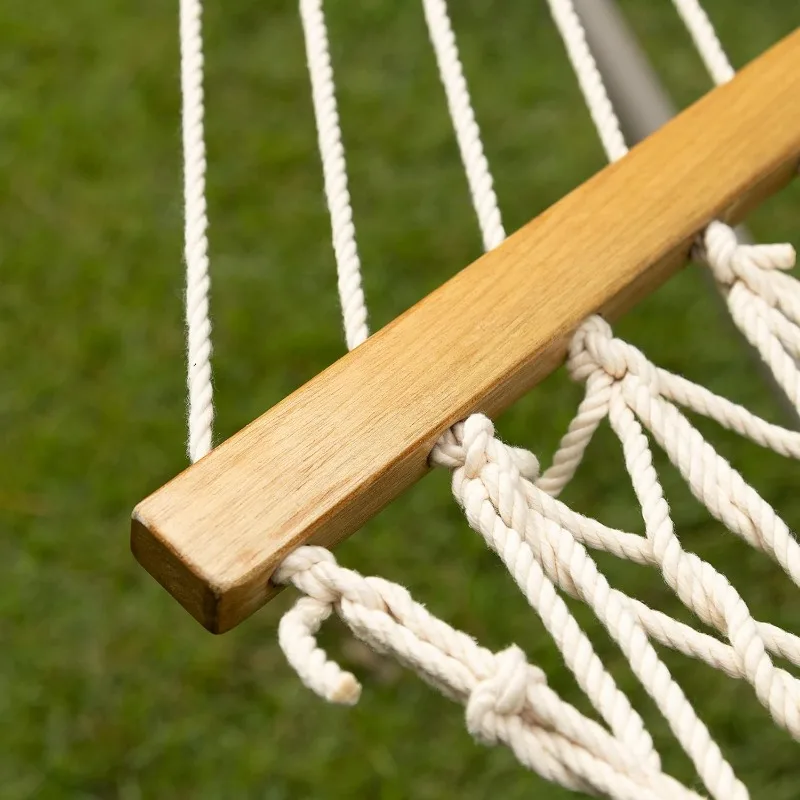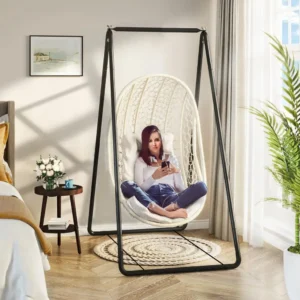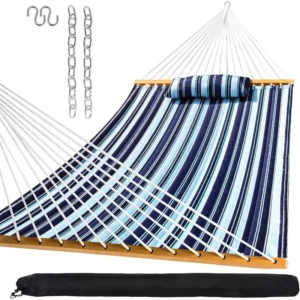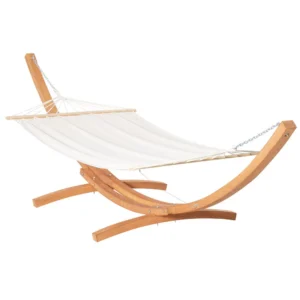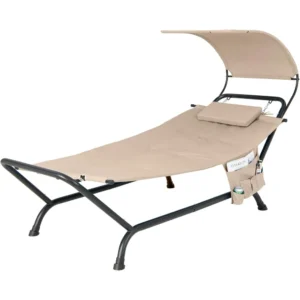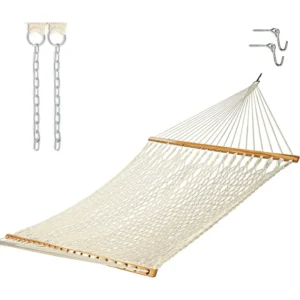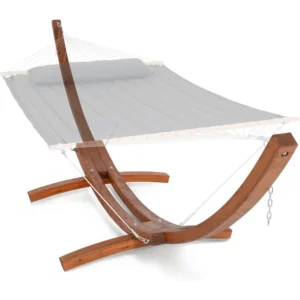Introduction: Embracing Outdoor Serenity with Cotton Rope Hammocks
Few outdoor comforts rival the gentle sway of a cotton rope hammock. The classic appeal of these natural fiber retreats has endured through generations, offering a timeless way to relax and connect with nature. But if you’re considering adding one to your outdoor space, you might be wondering: “Are cotton hammocks truly suitable for outdoor environments?”
It’s a valid question. Cotton’s natural comfort comes with specific care requirements when exposed to the elements. This guide will help you understand:
- The unique properties that make cotton hammocks so comfortable
- Realistic expectations for outdoor durability
- Essential maintenance practices to maximize lifespan
- How to choose the right cotton rope hammock for your needs
With proper knowledge and care, a cotton rope hammock can become your favorite outdoor retreat for years to come. Let’s explore how to make the most of these classic relaxation pieces by understanding proper hammock placement for outdoors and exploring the variety of rope hammock sets available.
Understanding Cotton Rope Hammocks: Comfort vs. Outdoor Realities
Cotton rope hammocks occupy a unique position in the outdoor furniture market. They represent a balance between undeniable comfort and practical considerations. While synthetic materials have grown in popularity for their weather resistance, many people still prefer cotton for its unmatched natural feel and traditional aesthetic.
The reality is that cotton rope hammocks require a different approach to outdoor use than their synthetic counterparts. Rather than viewing this as a drawback, think of it as making an informed trade-off: exceptional comfort in exchange for more attentive care. With the right knowledge and maintenance routine, you can enjoy the best of both worlds.
Understanding whether you can leave hammocks outside is crucial for cotton varieties in particular, as their care requirements differ significantly from synthetic alternatives.
The Unmatched Comfort and Natural Appeal of Cotton
Cotton rope hammocks have earned their loyal following for good reason:
- Superior softness against skin – Cotton fibers have a natural softness that synthetic materials struggle to replicate, making them exceptionally comfortable against bare skin on warm days
- Excellent breathability – The natural fibers allow air circulation, preventing the sticky, sweaty feeling sometimes experienced with synthetic materials
- Temperature regulation – Cotton naturally wicks moisture and adjusts to your body temperature, keeping you comfortable in varying conditions
- Classic aesthetic appeal – The traditional woven appearance blends harmoniously with natural surroundings, enhancing your outdoor space
These natural comfort advantages explain why many outdoor enthusiasts continue to choose cotton despite its maintenance needs. Understanding key fabric hammock features for outdoor comfort can help you appreciate what makes cotton special among the available options.
The Outdoor Challenge: Why Cotton Requires Special Attention
Moisture Absorption & Degradation Risks
Cotton fibers naturally absorb water at a much higher rate than synthetic alternatives. This high absorption capacity means cotton hammocks can:
– Retain moisture for extended periods after rain or morning dew
– Become significantly heavier when wet, increasing stress on attachment points
– Create ideal conditions for mold and mildew growth when damp
– Experience fiber weakening and eventual rot if left consistently wet
– Stretch more dramatically when wet, affecting hanging height and tension
UV Radiation Exposure & Fiber Breakdown
Continuous sun exposure presents another significant challenge for cotton fibers:
– UV radiation gradually breaks down the natural cotton fibers
– This breakdown process reduces tensile strength over time
– Color fading occurs more rapidly in cotton than in UV-resistant synthetics
– The combination of UV damage and natural stretching can accelerate wear
Environmental Factors & Pests
Cotton’s natural origin makes it more vulnerable to environmental challenges:
– High humidity environments accelerate mildew formation
– Even morning dew can create enough moisture to require drying in some climates
– Being plant-based, cotton can attract certain insects and small animals
– Pollen, tree sap, and bird droppings can penetrate fibers more deeply than with synthetic materials
Natural Stretching and Sagging
Cotton rope naturally stretches with use:
– Initial stretching during the first few uses is normal and expected
– Moisture significantly amplifies stretching, sometimes requiring readjustment
– Over time, this natural stretching affects both aesthetics and comfort
– Weight capacity ratings may need more conservative interpretation compared to synthetic hammocks
Maximizing Durability: Essential Care & Maintenance for Outdoor Cotton Rope Hammocks
With thoughtful care, a cotton rope hammock can provide years of outdoor enjoyment. Proper maintenance isn’t just about extending lifespan—it’s about preserving the comfort and beauty that attracted you to cotton in the first place.
The key to success lies in three essential areas: strategic placement, protection from harsh elements, and regular cleaning. Each of these practices works together to counteract cotton’s natural vulnerabilities while allowing you to enjoy its benefits.

Strategic Placement: Choosing the Optimal Location
Where you place your cotton rope hammock dramatically affects its longevity. Consider these placement guidelines:
- Prioritize partial shade – Position your hammock where it receives filtered sunlight rather than direct exposure all day
- Ensure good airflow – Choose locations with natural breezes to help dry the hammock after morning dew or rain
- Maintain ground clearance – Keep the hammock body at least 12-18 inches above ground to prevent moisture absorption from below
- Distance from water sources – Place hammocks at least 10 feet from sprinklers, pools, or water features
- Consider natural protection – Use existing structures like pergolas or tree canopies for added protection
Common placement mistakes include positioning hammocks in low-lying areas where moisture collects or in locations with full sun exposure during peak UV hours. For a detailed approach to perfect hammock placement in your home and garden, consider factors like sun patterns throughout the day.
Protection from the Elements: When and How to Store Your Hammock
Routine Protection (Daily/Short-Term)
Developing simple protection habits significantly extends your hammock’s life:
– Bring your hammock indoors during rainstorms or when not in use for several days
– Consider using a waterproof hammock cover for quick protection during brief showers
– Remove the hammock body (leaving the hanging hardware) during extended rainy periods
– Create a simple routine—perhaps bringing it in while doing other evening outdoor tasks
Seasonal & Extended Storage
For longer periods without use, proper storage is essential:
– Clean thoroughly before storage (see cleaning section below)
– Ensure the hammock is completely dry before storing to prevent mildew
– Store in a cool, dry place with good ventilation
– Use a breathable cotton storage bag rather than plastic containers
– Add cedar blocks or sachets to deter pests during storage
Consider spreader bar hammocks which offer better drainage capabilities, making them slightly more forgiving in damp conditions when proper storage isn’t immediately possible.
Cleaning Your Cotton Rope Hammock: A Detailed Guide
Initial Preparation
Before deep cleaning, remove loose debris:
1. Hang the hammock in a convenient cleaning location
2. Brush off loose dirt, leaves, and debris with a soft brush
3. Shake gently to remove additional particles from between ropes
Gentle Hand Washing Procedure
Machine washing can damage the rope structure, so hand washing is strongly recommended:
Required supplies:
– Large tub or clean kiddie pool
– Mild, pH-neutral detergent (avoid bleach or harsh chemicals)
– Soft brush for gentle scrubbing
– Clean water for rinsing
Step-by-step process:
1. Fill the tub with lukewarm water and mild soap
2. Submerge the hammock completely
3. Let soak for 15-30 minutes
4. Gently agitate and softly scrub problem areas
5. Drain soapy water
6. Rinse thoroughly with clean water until no soap remains
Addressing Stubborn Stains and Mildew
For tougher cleaning challenges:
Mildew solution:
– Mix 1 part white vinegar with 4 parts water
– Apply directly to affected areas
– Let sit for 15 minutes
– Scrub gently with soft brush
– Rinse thoroughly
For stubborn stains:
– Create paste with baking soda and water
– Apply to stained areas
– Let sit for 30 minutes
– Scrub gently
– Rinse completely
Proper Drying Techniques
Thorough drying is perhaps the most critical step:
– Hang the hammock in a sunny, breezy location
– Ensure the hammock is spread open to maximize airflow between ropes
– Rotate occasionally for even drying
– Allow at least 24-48 hours for complete drying before using or storing
– Never fold or store while damp, even slightly
Cotton Rope Hammocks vs. Other Outdoor Materials: A Comparative Guide
When selecting a hammock for outdoor use, it’s helpful to understand how cotton compares to alternative materials. Rather than viewing any material as universally “best,” consider each option’s strengths across different categories:
- Comfort: The tactile feel and body-conforming properties
- Durability: Resistance to environmental factors and expected lifespan
- Maintenance: Time and effort required for proper care
- Cost: Initial investment and long-term value
- Climate Suitability: Performance in your specific environment
Your ideal choice depends on which factors matter most to you and your willingness to balance trade-offs between them.
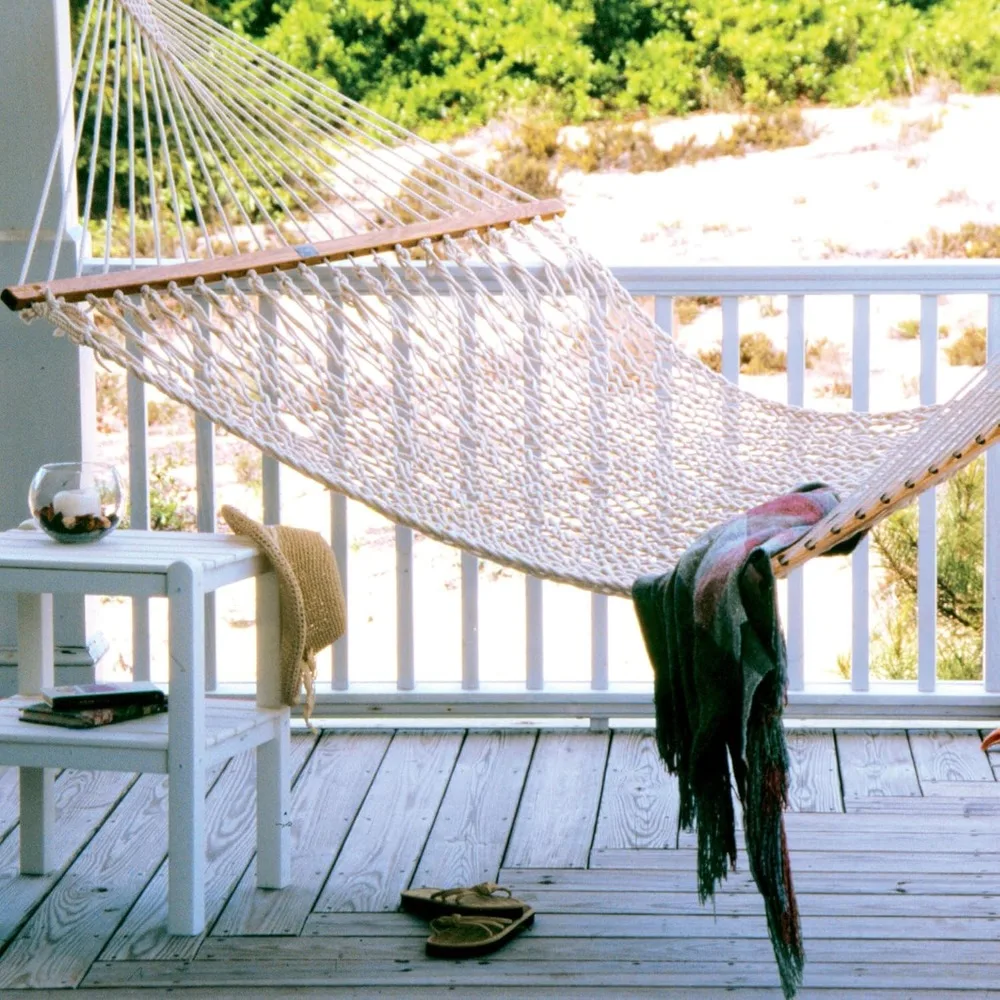
Cotton vs. Polyester Rope Hammocks
| Feature | Cotton Rope | Polyester Rope |
|---|---|---|
| Initial comfort | Exceptionally soft, forms to body | Slightly stiffer but softens with use |
| Weather resistance | Requires protection from elements | Good resistance to moisture and UV |
| Maintenance needs | Regular cleaning and proper storage | Occasional rinsing, minimal storage needs |
| Expected outdoor lifespan | 2-5 years with proper care | 5-8+ years with basic care |
| Price range | $80-200 for quality options | $100-250 for comparable quality |
Cotton provides superior initial comfort with its soft, natural feel and excellent breathability during hot weather. However, polyester offers significantly better weather resistance, requiring much less maintenance for outdoor use.
For humid or rainy climates, polyester’s quick-drying properties make it more practical for consistent outdoor use. Cotton performs best in dry climates with low humidity or in settings where it can be easily protected or brought indoors.
For detailed information about material differences, our guide comparing indoor versus outdoor hammocks provides comprehensive insights.
Cotton vs. Nylon Hammocks
| Feature | Cotton Rope | Nylon |
|---|---|---|
| Primary design | Stationary relaxation | Portable camping/travel use |
| Weight | Heavier (8-15 lbs) | Ultra-lightweight (1-2 lbs) |
| Weather performance | Absorbs moisture, slow to dry | Highly water-resistant, quick-drying |
| UV resistance | Poor to moderate | Moderate to good |
| Price range | $80-200 | $40-120 |
The comparison between cotton and nylon reflects fundamentally different design purposes. Nylon hammocks primarily serve as portable, lightweight options for camping and hiking, while cotton rope hammocks are designed for stationary, long-term relaxation in a fixed location.
Nylon’s technical performance outdoors far exceeds cotton, with superior weather resistance, quicker drying times, and better UV protection. However, cotton maintains an advantage in comfort for extended lounging, especially in moderate temperatures.
Cotton vs. High-Performance Synthetic Blends
| Feature | Cotton Rope | High-Performance Synthetics |
|---|---|---|
| Weather resistance | Requires protection | Engineered for outdoor exposure |
| Comfort | Natural softness | Designed comfort with technical benefits |
| Expected lifespan | 2-5 years outdoors | 10+ years with minimal care |
| UV resistance | Minimal | High (often 1000+ hours) |
| Price range | $80-200 | $200-400+ |
| Color retention | Fades over time | Minimal fading for years |
Premium synthetic materials like DURACORD® and Sunbrella fabrics represent significant advancements in outdoor performance. These materials maintain impressive softness while offering dramatic improvements in weather resistance, often with specific UV ratings exceeding 1,000 hours of direct exposure.
The price difference reflects this performance gap, with high-end synthetics typically costing 2-3 times more than comparable cotton hammocks. However, when considering their substantially longer lifespan (often 3-5 times longer outdoors), premium synthetics may represent better long-term value despite higher initial cost.
When is Cotton the Ideal Choice for Your Outdoor Space?
Cotton rope hammocks excel in specific situations:
- Protected outdoor areas – Covered patios, porches, gazebos, or areas with significant natural shade
- Seasonal use – Summer-only setups where the hammock can be properly stored during off-seasons
- Low-humidity climates – Dry environments where moisture concerns are minimized
- Appearance priority – Settings where the classic, natural aesthetic is an important design element
- Regular maintenance capability – Households with the time and willingness to provide proper care
For situations requiring exceptional durability with minimal maintenance, consider heavy-duty hammock sets that balance comfort with enhanced weather resistance.
Buying Considerations for Outdoor Cotton Rope Hammocks
Selecting the right cotton rope hammock for outdoor use requires attention to several key factors beyond just appearance. Quality differences significantly impact both comfort and outdoor durability, making careful selection particularly important if you plan to use your hammock outdoors.
The following sections will guide you through the most important considerations when evaluating cotton rope hammocks for your outdoor space.
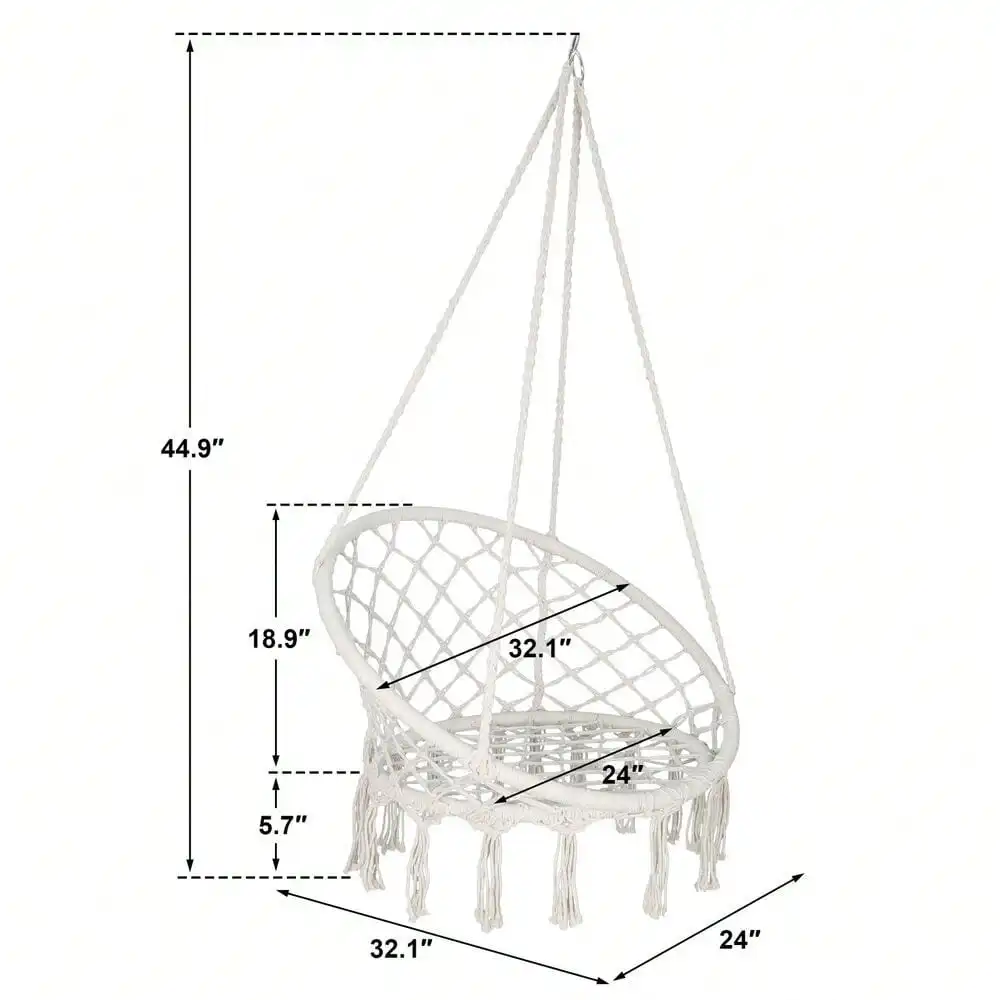
Understanding Rope Quality & Weave Types
The quality of cotton rope and weave pattern directly affects both comfort and durability:
Rope thickness and ply:
– 3-ply ropes (three strands twisted together) offer basic durability
– 4-ply and 5-ply options provide enhanced strength for outdoor applications
– Thicker ropes (⅜” or larger diameter) generally last longer outdoors
Weave density impact:
– Tighter weaves typically provide better support and durability
– Looser weaves offer more breathability and faster drying
– Balanced weaves combine support with adequate airflow
Common cotton hammock weave patterns:
– Mayan/Mexican style – Traditional gathered-end design without spreader bars, excellent for body conforming
– Brazilian weave – Typically tighter pattern with excellent weight distribution
– Caribbean/Nicaraguan style – Often features distinctive decorative patterns with varying rope density
The rope quality and weave density directly impact how well a cotton hammock will endure outdoor conditions. For various options with different weave patterns, explore our selection of double cotton rope hammocks designed for two-person relaxation.
Spreader Bars: Pros and Cons for Outdoor Hammocks
Spreader bars significantly affect both the comfort and outdoor durability of cotton rope hammocks:
Advantages:
– Creates a flatter, more bed-like surface
– Prevents rope tangles during storage and use
– Provides classic aesthetic many people prefer
– Makes entry and exit easier for many users
Outdoor challenges:
– Can collect water between ropes during rain
– May take longer to dry completely after exposure to moisture
– Requires more attention to rope tension as cotton stretches
– Less forgiving of improper weight distribution
For outdoor use, cotton hammocks with spreader bars typically require more attentive care to prevent moisture accumulation between ropes. Some modern designs feature slightly angled spreader bars that promote better water runoff while maintaining the classic look and feel.
Weight Capacity and Size: Matching to Your Needs
Selecting the appropriate size ensures both comfort and safety:
| Size | Typical Dimensions | Weight Capacity | Best For |
|---|---|---|---|
| Single | 4-5 ft wide | 250-300 lbs | Individual users |
| Double | 5-6 ft wide | 350-450 lbs | Couples or single users who prefer space |
| Family/XL | 6-8 ft wide | 450-600+ lbs | Multiple users or maximum lounging space |
For outdoor cotton hammocks specifically, consider:
– Reducing the stated weight capacity by 10-15% to account for natural stretching
– Adding 2-3 feet to the stated hanging distance for proper installation with cotton’s natural stretch
– Allowing for additional stretching when the hammock becomes wet
Understanding factors affecting lightweight hammock durability will help you choose a size that balances comfort with longevity.
Essential Accessories for Enhanced Durability and Convenience
The right accessories can significantly extend the outdoor lifespan of a cotton rope hammock:
Hammock Stands:
– Powder-coated steel or aluminum stands resist rust and outdoor elements
– Wooden stands should be treated for outdoor use with appropriate sealants
– Adjustable stands allow for tension modification as cotton naturally stretches
Protective Covers:
– Water-resistant covers designed specifically for hammocks
– Quick-deploy designs for sudden weather changes
– UV-protective fabrics for added protection when not in use
Storage Solutions:
– Breathable cotton storage bags prevent moisture buildup
– Hanging storage options to maintain rope shape during off-seasons
– Compact designs for efficient space use during storage periods
Weather-Resistant Hardware:
– Stainless steel chains and hooks resist corrosion
– Tree-friendly straps distribute weight and protect bark
– Quick-connect systems for easy installation and removal
A-Frame Stand Hammock Sets, Swinging Hammock Chair Sets
$154.62 Select options This product has multiple variants. The options may be chosen on the product pageClassic Wooden Stand Hammock Sets, Heavy Duty Hammock Sets
$1,061.68 Select options This product has multiple variants. The options may be chosen on the product pageHammock Sets with Canopy, Heavy Duty Hammock Sets
$286.31 Select options This product has multiple variants. The options may be chosen on the product pageDouble / Two Person Hammock Sets, Rope Hammock Sets
Double Traditional Cotton Rope Hammock with Extension Chains – 450 lbs Capacity for Backyard & Patio$292.98 Select options This product has multiple variants. The options may be chosen on the product pageHeavy Duty Hammock Sets, Wooden Arc Stand Hammock Sets
$878.66 Select options This product has multiple variants. The options may be chosen on the product page
Frequently Asked Questions About Cotton Rope Hammocks Outdoors
How long will a cotton rope hammock last outdoors?
With proper care and maintenance, a quality cotton rope hammock can last 2-5 years with regular outdoor use. This includes bringing it in during inclement weather, cleaning as needed, and storing during off-seasons. Without these protective measures, outdoor exposure may reduce lifespan to less than a year.
Can cotton rope hammocks be left outside overnight?
Ideally, cotton rope hammocks should not be left outside overnight, especially in humid climates where morning dew can create significant moisture. For occasional overnight use, consider a waterproof cover or choose locations with overhead protection.
How often should I clean my outdoor cotton hammock?
For regular maintenance, brush off debris weekly. For hammocks used frequently outdoors, plan for a thorough cleaning every 1-2 months during the active season. Clean immediately if the hammock becomes wet from rain or shows signs of mildew.
What does “weather-resistant cotton” really mean?
When manufacturers describe cotton as “weather-resistant,” it typically means the fibers have been treated with protective coatings that provide temporary water resistance. These treatments diminish with time and exposure, requiring reapplication or increased protection as the hammock ages.
How can I repair small breaks in cotton rope?
Small breaks can often be repaired by splicing in new cotton rope of the same diameter and securing with appropriate knots. For spreader bar hammocks, individual rope sections can sometimes be replaced without rebuilding the entire hammock.
Conclusion: Balancing Comfort and Practicality for Your Outdoor Oasis
Cotton rope hammocks offer a unique combination of natural comfort and classic appeal that continues to attract outdoor enthusiasts despite the availability of high-tech alternatives. The unmatched softness against skin, superior breathability, and traditional aesthetic make cotton a perennial favorite for creating inviting outdoor relaxation spaces.
Success with outdoor cotton hammocks comes down to realistic expectations and appropriate care. By understanding the material’s natural properties and implementing the maintenance practices outlined in this guide, you can enjoy the best of both worlds—the exceptional comfort of cotton with reasonable outdoor durability.
When selecting a cotton rope hammock for outdoor use, carefully evaluate your climate, usage patterns, and willingness to perform regular maintenance. In the right setting with proper care, a quality cotton rope hammock becomes more than just a piece of outdoor furniture—it becomes a personal retreat that connects you to nature while providing unparalleled comfort.
Explore Our Collection of Outdoor-Ready Hammocks
At Outside Luxe, we understand the importance of finding the perfect balance between comfort, style, and durability for your outdoor living space. Our premium hammock collection features carefully selected cotton rope options alongside weather-resistant alternatives to suit every preference and environment.
Browse our extensive range of hammock styles, from traditional cotton rope designs to innovative synthetic options that require minimal maintenance. Each hammock in our collection undergoes rigorous quality testing to ensure exceptional comfort and appropriate durability for its intended use.
Complete your outdoor relaxation setup with our matching stands, protective accessories, and complementary pieces designed to enhance both the longevity and enjoyment of your hammock experience.

